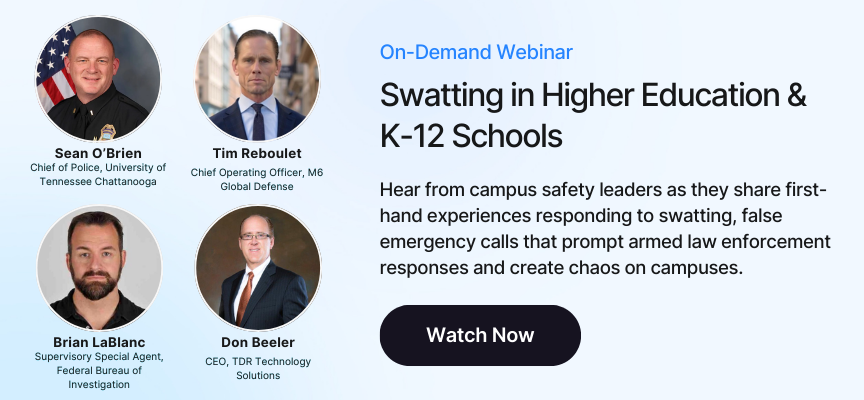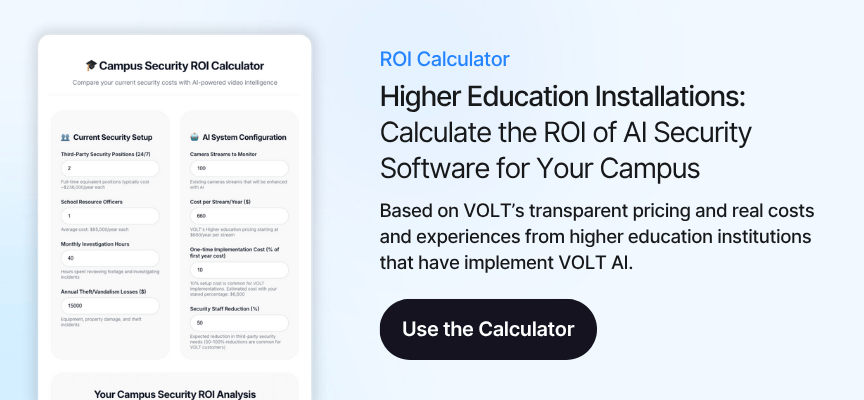Key Points
- Financial Impact: A single swatting threat incident can cost schools between $78,000 and $1.4 million in lost instructional time, student absenteeism, and mental health impacts
- Four Cost Categories: Schools face expenses from direct instructional loss, student absenteeism, mental health effects, and physical damage
- Communication Multiplier: Poor threat communication can increase incident costs by 1,700%, turning a $78K event into a $1.4M crisis
- Real-Time Verification Value: Advanced AI systems with human validation can reduce swatting impact costs by up to 37%
- Mental Health Toll: Approximately 36% of students experience anxiety that impairs learning ability following a threat
When a Phone Call Costs Nearly a Million Dollars
What is Swatting?
Swatting is the act of making false reports to emergency responders to trigger a large-scale law enforcement response, often involving SWAT teams. These hoax threats typically involve active shooter reports, bomb threats, or hostage situations designed to create maximum disruption.
The University of Tennessee Chattanooga received what appeared to be an active shooter call on August 28, 2024. A voice on the administrative line claimed someone with a rifle was shooting near the library. AI-generated gunshot sounds played in the background.
Officers arrived within minutes. The incident lasted approximately two hours. Campus police cleared three buildings and evacuated students. That single swatting threat cost the university $910,000 in lost instructional time alone.
Schools across the United States face a growing crisis. Swatting incidents have cost taxpayers over $1 billion in the last two years. These represent substantial financial losses that directly impact educational budgets and student learning outcomes. In 2023 alone, at least 723 swatting hoaxes targeted K-12 schools, with the trend showing no signs of slowing.
Understanding the True Cost of Swatting Threats: Four Categories That Add Up Fast
Schools experience swatting threat costs across four distinct categories. Each category compounds the others, creating financial burdens that extend far beyond immediate incident response. Understanding these cost drivers helps administrators develop more effective prevention and response strategies.
Lost Instructional Time: The Immediate Financial Hit
Lost instructional time represents the most visible cost category. When a swatting threat occurs during school hours, instruction stops completely. Students evacuate buildings or shelter in place. Teachers cannot deliver lessons.
The calculation multiplies affected students by hours of lost instruction and per-hour education cost. For K-12 schools, the national average instructional cost is $12.21 per student per hour. Higher education institutions typically see higher per-hour costs due to more expensive instructional models.
Chattanooga Incident Cost Breakdown | Amount | Calculation Basis |
Students Affected | 12,000 | Total enrollment |
Lost Instructional Hours | ~2 hours | Incident duration |
Cost Per Student Hour | $37.92 | Higher ed rate |
Total Direct Cost | $910,000 | Students × Hours × Rate |
Schools cannot easily recover this lost time. The academic calendar operates on carefully planned schedules with limited flexibility for makeup instruction.
Student Absenteeism: The Ripple Effect
Student absenteeism following a swatting threat creates a second wave of costs. Even after authorities deem a threat non-credible, many parents remove their children from school.
Research tracking swatting incidents shows a consistent pattern:
- Day of incident: Approximately 20% of students leave school early
- Following day: Another 20% stay home due to safety concerns
- Extended impact: A one-hour threat generates the equivalent of half a day's closure
The extended impact multiplies the initial cost significantly. Schools lose instructional value for these absent students, adding substantially to the total financial burden.
Mental Health Impact: The Hidden Cost
Mental health costs represent the least visible but potentially most significant category. Approximately 36% of K-12 students experience anxiety severe enough to impair learning ability following a threat incident.
The National Survey of Children's Exposure to Violence found that over 60% of children who experience traumatic events show lasting effects. These aren't abstract statistics. They translate to students who cannot concentrate, cannot retain information, and cannot perform on assessments.
Students experiencing anxiety-related learning impairment essentially lose an average of 2.18 hours of instructional benefit per incident. At the national average instructional rate, this translates to approximately $26-32 per affected student. For a school with 1,000 students, the mental health cost alone can exceed $26,000 per incident.
Physical Damage and Response Costs
The fourth category encompasses physical damage and emergency response expenses. These costs include law enforcement deployment, potential property damage during evacuations, and equipment or facility issues arising from emergency procedures.
The Ladue School District incident in September 2023 saw 30 police departments respond to a single Facebook post. Schools face similar multi-agency responses that strain both school and community resources.
How Poor Communication Multiplies Costs by 1,700%
Two schools experienced nearly identical threats. One had clear communication protocols. The other did not. The cost difference: $78,000 versus $1.4 million.
Communication Approach | Incident Cost | Key Factors | Cost Multiplier |
Unified Protocol | $78,000 | Single source, consistent messaging, rapid updates | Baseline |
Poor Coordination | $1,400,000 | Conflicting messages, social media chaos, extended crisis | 17.9x |
The school with unified communication immediately established a single source of accurate information. Administrators coordinated messaging across all platforms. Parents received consistent updates. Students returned to normal schedules quickly.
The school without unified communication faced cascading failures. Multiple conflicting messages reached parents through various channels. Social media spread unverified information. News interviews featured inconsistent statements. Parents panicked. Students stayed home for days.
The 1,700% cost difference demonstrates a crucial principle. How schools communicate during and after a swatting threat matters as much as how they respond operationally.
Real-Time Verification Changes the Cost Equation
Advanced AI security systems with human validation can substantially reduce swatting impact costs. The key lies in speed and accuracy of threat verification, combined with complete situational awareness before emergency protocols activate.
Traditional security approaches force schools into reactive stances. Dispatchers receive a call, sound the alarm, and trigger full emergency responses. This assumption carries enormous financial consequences when threats prove false.
How Verification Reduces Costs
Modern AI-powered video intelligence systems change this equation through several integrated capabilities:
- Continuous Monitoring: AI systems analyze 100% of camera feeds 24/7, creating baseline behavioral patterns for each location
- Instant Threat Assessment: Security teams immediately check claimed locations when swatting calls arrive
- Human-in-the-Loop Validation: Every weapon detection alert receives human validation through VOLT's VSOC before reaching first responders
- 3D Facility Mapping: Security teams view incidents within dynamic 3D representations of their facilities
The University of Illinois Chicago demonstrated these capabilities effectively. When facing staffing shortages, the university used AI-powered monitoring to maintain security coverage. The system's ability to distinguish real threats from false reports reduced their reliance on costly third-party security services.
Response Method | Per-Student Cost | 1,500-Student School | Annual Savings (3 incidents) |
Traditional Response | $101.59 | $152,385 per incident | Baseline |
AI-Verified Response | $64.12 | $96,180 per incident | $168,615 |
Cost Reduction | 37% | $56,205 per incident | — |
Schools using advanced verification systems have seen measurable cost reductions. The average cost per student per threat dropped 37% when schools implemented better threat assessment protocols. This reduction came primarily from avoiding unnecessary full-scale responses to obviously false threats.
Preventing Swatting Threats: Five Actions to Minimize Costs
Schools can implement specific measures to minimize swatting costs without compromising safety. These protocols focus on rapid verification, clear communication, and measured response appropriate to confirmed threat levels.
1. Train Dispatchers on Swatting Patterns
Swatting calls follow predictable patterns. Trained dispatchers can identify red flags within the first 30 seconds of a call:
- Call source: Typically come through non-emergency lines rather than 911
- Detail level: Lack specific, verifiable details about the threat
- Corroboration: Single caller with no corroborating reports
- Timing: Often occur during high-activity periods for maximum disruption
The FBI's swatting training program teaches dispatchers to implement tactical pauses. A tactical pause means taking 15-30 seconds to gather additional information before triggering full emergency protocols. Schools should ensure their dispatch centers receive this specialized training.
2. Integrate AI-Powered Verification Technology
Schools already operating IP camera systems can enhance these investments with AI-powered analytics. The technology integrates with existing infrastructure, eliminating hardware replacement needs. Implementation typically occurs within 24 hours for cloud deployments.
The verification capability provides immediate value. Security teams gain real-time visibility into every monitored location. When threat calls arrive, verification happens in seconds rather than minutes.
3. Establish Unified Communication Protocols
Schools must establish and practice unified communication protocols before incidents occur:
- Single Source of Truth: One designated official serves as the sole source of public information during incidents
- Pre-Approved Templates: Develop and approve message templates for various threat scenarios in advance
- Multi-Channel Coordination: All channels must deliver identical core information
- Rapid Update Cycles: Push updates at regular intervals even if information hasn't changed
UTC demonstrated effective communication during their incident. The principal had his director of communications immediately beside him throughout the event. They pushed regular updates to the campus community as the response progressed.
4. Build Relationships with Law Enforcement
Strong relationships between school administrators and law enforcement agencies prove invaluable during swatting incidents. These relationships enable rapid information sharing, collaborative threat assessment, and coordinated response decisions.
Schools should establish regular communication channels with local law enforcement before incidents occur. Joint training exercises, shared threat intelligence, and coordinated response planning all contribute to more effective incident management.
5. Invest in Prevention Technologies
The most cost-effective approach to swatting threats is prevention. Technology solutions like SAM (School Access Manager) prevent many swatting calls from ever reaching schools. The system monitors incoming calls, identifies patterns consistent with swatting attempts, and blocks these threats before they disrupt operations.
Prevention costs a fraction of response costs. A comprehensive prevention system might cost less than a single serious swatting incident. When schools experience multiple threats per year, the cost-benefit calculation becomes overwhelmingly favorable for prevention investment.
Protecting Both Safety and Budgets
The financial imperative is clear. Schools cannot afford to treat swatting as an inevitable operational cost. Every incident diverts resources from education to crisis management. Every evacuation costs tens or hundreds of thousands of dollars. Every threat creates anxiety that impairs student learning for days or weeks afterward.
Advanced security technologies with real-time verification capabilities provide schools with tools to minimize these costs. When combined with proper training, clear protocols, and strong law enforcement partnerships, these technologies enable schools to maintain safety while dramatically reducing the financial burden of false threats.
The hidden costs of swatting are no longer hidden. Schools understand the financial impact. The question now is whether they will invest in the technologies and protocols that minimize these costs while maintaining the safety standards their communities demand.






